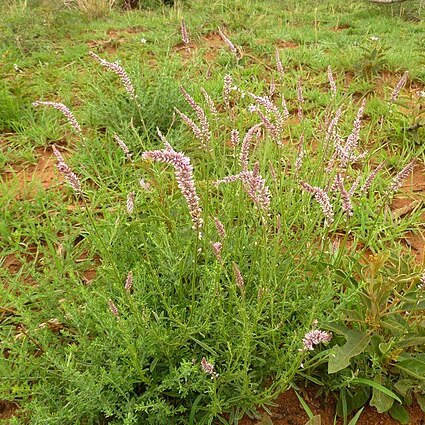Leaves narrowly linear to linear-oblanceolate to obovate-spathulate, more or less obtuse (or rather acute in very narrow-leaved forms), narrowed below, or distinctly petiolate and lower leaves with a narrowly elliptic lamina in broader-leaved forms, 10–50 × 0.8–10 mm. at the centre of the stem and branches but decreasing upwards, more or less glabrous to somewhat pilose with rather stiff divergent hairs along the venation of the lower surface; small-leaved axillary shoots frequently but not invariably present in the axils of the upper or all leaves.
Tepals narrowly to broadly elliptic-oblong or oblong-obovate, the outer (2.5) 4–6 (7) mm. long, white or pink-tinged to orange or carmine, 3–7 (9)-nerved with the midrib excurrent in a very short mucro and 1–3 pairs of (sometimes branched) lateral nerves reaching well above the middle, and usually other shorter nerves; inner tepals similar but not infrequently fewer-nerved and slightly narrower.
A herb or small shrub. It is erect and keeps growing from year to year. It has rhizomes or underground stems and grows 75 cm high. The leaves are alternate and 5 cm long by 1 cm wide. They taper at both ends. The flowers are in spikes at the top of the plant and these often droop. The flowers are small, papery and red or orange and in spirals around the stem. There are 3 named varieties.
Stems branched distally, pu-bescent. Leaves scattered on stem; blade 1-2 cm × 1-1.5 mm. Inflorescences elongate spikes; bracts and bracteoles 2.5-5 mm, membranous. Flowers white or pinkish; tepals 3-5-veined at base, equal, 4-7 mm; stamens 5; ovary ovoid. Utricles enclosed by staminal tube, 3-4 mm. Seeds lenticular, ± circular in outline, 1 mm diam., glossy.
Bracts c. (1.5) 2.5–3.5 mm. long, lanceolate to lanceolate-ovate, hyaline with a darker midrib which is excurrent in a short, fine arista, glabrous or finely ciliate, sometimes erose-denticulate; bracteoles shorter and broader, 2–3 (3.5) mm. long.
Stamens fused into a tube for two thirds to three quarters of their length, clearly shorter than the tepals; antheriferous tooth much shorter than the alternating deeply bifid pseudo-staminodes, which more or less equal or overtop the anthers.
Ovary (2) 4–8-ovulate, rather squat, rounded or very shortly narrowed above; stigmas 2–3 (5), spreading or recurved, much longer than the very short (rarely to 1 mm. long) or almost obsolete style, rarely exceeding the androecium.
Inflorescences terminal on both the stem and branches, spicate, c. (1) 5–30 × 0.6–1.25 cm., considerably elongating, the axis moderately to densely furnished with whitish, floccose hairs.
Erect or ascending perennial herb, 15–60 cm., with a tuberous rootstock; stems several, simple to considerably branched, sometimes quite bushy, branches divaricate at 30 degrees or more.
Stem and branches subterete or somewhat angled, striate, moderately to rather densely furnished with fine, flexuose, whitish hairs, rarely glabrous.
Capsule oblong-ovoid, c. 2.5–3.5 mm. long, circumcissile, the lid campanulate and shortly tapering above, smooth.
Seeds c. 1 mm.

